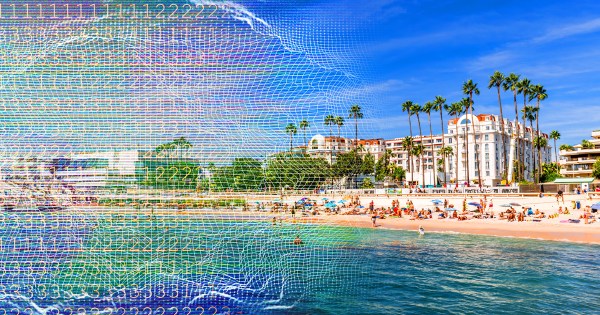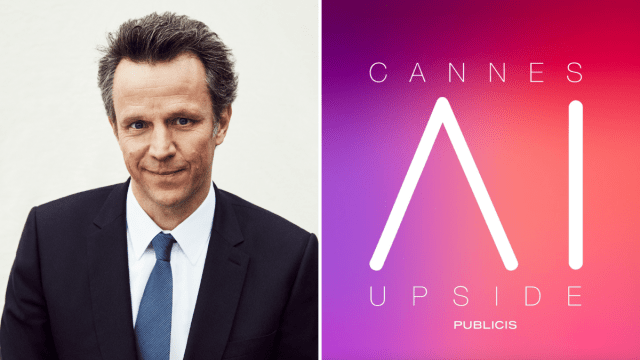AI was the undisputed hot topic among the more than 15,000 attendees at this year’s sweltering five-day Cannes Lions International Festival of Creativity.
In public, CMOs and agency chiefs struck an upbeat tone, positioning the tech as a tool to supercharge human creativity, not replace it.
However, as the Riviera temperature climbed, so did the tension, and multiple industry execs told ADWEEK of their quiet anxieties about what AI means for creative agencies, media buying, search, industry jobs, and established business models.
On the Palais stage, optimism was in the air. Apple’s Tor Myhren addressed the audience with a keynote rallying for human creativity. Microsoft’s Mustafa Suleyman spoke to former Snap CCO Colleen DeCourcy about AI’s creative opportunity. Adobe CEO Shantanu Narayen chatted with Publicis Groupe CEO Arthur Sadoun about how AI is empowering creative teams.
Meta, Google, Adobe, and more showed off shiny new generative AI tools along the Croisette—demonstrations that fueled both curiosity and unease.
Sir Martin Sorrell, industry veteran and founder of S4 Capital, told ADWEEK that the mood at Cannes was “not good,” saying the 2025 festival marked the end of advertising’s current “golden era.” “Huge changes are coming,” he added.
Sorrell described AI’s impact on the traditional ad industry as “existential,” noting an exec from a major ad platform told him during a dinner they were “very concerned” about AI’s impact not just on advertising, but on industry employment.
In May, Forrester reported that the U.S. ad industry will lose 7.5% of agency jobs (roughly 32,000 roles) to automation by 2030.
“The big theme this week [was], is AI going to upend the industry? I really worry about it,” Sorrel added.
Michael Ruby, president and chief creative officer at indie agency Park & Battery, watched curiously the “bombastic optimism” around AI that was “staunchly parroted” on stage. But behind closed doors, he said the tension was palpable.
“The discomfort is painfully obvious,” Ruby said, echoing Sorrell: “We’ve got to get over it fast, because our industry is evolving in a way it hasn’t in 25 years.”
Agencies face a ‘Kodak moment’
David Jones, founder and CEO of the Brandtech Group, said the ad industry is facing its “Kodak moment.” He didn’t mince words: “If you’re a creative agency, you’re screwed.”
Sorrell observed that art director and copywriting jobs were most under pressure as new tools like Google’s Veo 3 produce more realistic outputs faster.
S4’s Monks agency has developed entirely gen AI-created commercials for Puma and other clients currently live in the market. Such projects can be produced in a matter of days and cost as little as a few hundred thousand dollars, versus spending millions on a shoot in an exotic location.
According to Jones, Brandtech has produced more than 2 million AI ads across 5,000 brands since 2018, including 235,000 in just one quarter. Jones said these ads, some made for three of the world’s top 10 advertisers, were produced 62% faster, 55% cheaper, and resulted in a 40% better ROI.
“I can now make you TV commercials whilst we sit and talk, and they’re pretty good,” Jones said. “Our best creative people can just do stunning stuff.”
Though Jones believes it’s creative agencies feeling the AI squeeze most, Sorrell points to the impact on media buyers, whose jobs he said “will all be done by algorithms,” eventually.
The S4 chief added that with the rise of AI coinciding with agency mega-consolidations, “we’ll lose jobs,” but the full impact has “not hit yet.”
“There’s going to be quite a lot of displacement,” Jones agreed, predicting that long-term agencies would slim down from hundreds of thousands of staff to tens of thousands.
Agencies must also develop new pricing models in an AI world, where clients are demanding personalization at scale, and at reduced costs. Charging on time and materials is no longer profitable when clients will demand work gets done quicker and with fewer people.
Some clients, for instance, pay Monks on an FTE-based retainer, but also for asset usage. Models like this will become more common in the future, Sorrell said.
That shift, while logical to agency leaders, is often a hard sell to procurement execs accustomed to time-based billing, Sorrell said. “That’s really tough, because the agency’s fee base is effectively being reduced.”
But it’s not all downside. Though Jones believes that “AI will be how 100% of all content is generated within five years,” he said “if you’re the best at [using AI], you’re going to be in a business that’s growing really fast.”
“There will be opportunity, but it’s going to mean huge changes,” Sorrell said, forecasting a “new golden era.”
One senior marketer ADWEEK bumped into on the Croisette joked ad execs were “depressed” about AI’s impact—though, like Sorrell, they remained glass-half-full on its potential.
CMOs Lean In, Cautiously
The CMOs holding the purse strings will ultimately shape what this next phase of AI adoption looks like.
But according to Bain partner Philip Dowling, there’s still “uneven maturity” and a “widening gulf” between brands investing in the tech and those struggling to keep up.
Along the Croisette, CMOs were at various stages of experimentation. Many were more bullish than their agency counterparts, but still prudent about the details, sharing softer, internal examples of AI in action throughout the week.
Natalia Ball, global chief growth officer at Mars Pet Nutrition, told ADWEEK: “Last year I was like, ‘Oh my God, AI, what is it going to be like?’” A year later, she’s “not worried.” In the 12 months since the industry last convened in Cannes, Mars Petcare is already using AI to deliver personalization at scale and smarter media planning. It’s also using AI in some campaigns, including one for Temptations that dressed up cats as dogs, and another that helped pet owner hopefuls convince their partners to bring home a furry friend through slick videos.
Amazon’s vp of global brand and marketing, Claudine Cheever, revealed on stage that she used the platform’s AI assistant Amazon Q to develop a bot that mirrors her writing style, streamlining the creation of “more Amazonian” marketing documents.
Netflix is cautiously exploring the tech inside its marketing department. CMO Marian Lee told ADWEEK during a press event that her team is applying AI to support tasks such as employee reviews. It also recently used Meta’s AI to localize subtitled Bridgerton campaigns across markets.
“We don’t use it for creative right now,” Lee said. “In terms of creative output, it’s not there yet. But it doesn’t mean we’re ignoring it, because every week it’s pretty phenomenal how much is changing.”
Hilton CMO Mark Weinstein called AI “the great equalizer for creative,” breaking down barriers previously imposed by budgets. At the moment, Gen AI is helping Weinstein’s team handle routine tasks such as photo reviews and writing copy for its 13 million hotel rooms.
Elsewhere, McLaren Racing CMO Louise McEwen is using AI to manage huge volumes of content, with as much as 1.5 terabytes generated per race weekend. “AI helps do the heavy lifting behind the scenes,” she said.
Banana Republic’s head of marketing, Meena Anvary, described her team’s conversations about AI as “future-facing,” with a focus on “human-centered” applications. The apparel brand is still working out what this looks like as parent company Gap Inc. cements its own AI blueprint.
Gap isn’t alone. “The biggest question we’re getting from clients is: how do I reshape my organization to adopt AI at scale?” said Bain’s Dowling.
Accenture Song’s incoming CEO, Ndidi Oteh, said clients were “excited” by AI but lacked the data infrastructure to implement it. Nearly a third (30%) of Song’s client engagements incorporate AI today, a number she expects to grow.
Agencies and consultancies updated their Cannes programming to cater to clients’ appetite for AI. Publicis hosted closed-door sessions for CMOs on its AI tech, while MediaLink held invite-only forums on AI’s impact. Havas declared itself an “AI-driven organization fueled by human ingenuity” at a press call, while WPP inked a deal with TikTok to bring more AI tools to clients.
While marketers and agencies have their eyes on the future, the void between their public optimism and private anxiety is hard to ignore.
Few captured that tension better than legendary Grey’s Anatomy and Bridgerton showrunner Shonda Rhimes, who told press on Netflix rooftop why human creativity still matters: “I’m not in a place where I want to walk into a writer’s room to hear what a computer has to say about how we’re going to tell a story,” she said.
“I still am arrogant enough to believe that a person’s creativity and imagination are the most important elements in storytelling right now.”
If the Cannes Lions Grand Prix winners this year were any indication, ad creatives are also still not ready to cede their human oversight to the machines—and neither are the juries.
Amid these seismic changes, ad creatives are largely burying their heads in the sand, Jones said. They have “huge anxiety” about what’s to come because “they’re not using the tools.”
“Partly out of fear, partly out of ignorance, [creatives] genuinely think that it is impossible that AI is more creative than humans,” he said. “It’s not a question of whether it will be; it’s when.”


